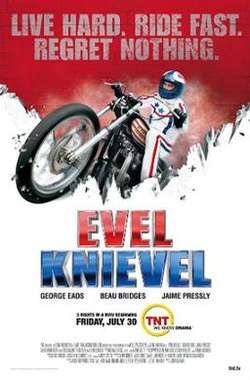Evel Knievel (2004 film)
| Evel Knievel | |
|---|---|
 | |
| Based on |
Evel Incarnate: The Life and Legend of Evel Knievel by Steve Mandich |
| Screenplay by | Jason Horwitch |
| Directed by | John Badham |
| Starring |
George Eads Jaime Pressly Lance Henriksen Fred Thompson Beau Bridges Matt Gordon Peter MacNeill |
| Composer(s) | Stewart Copeland |
| Country of origin |
United States Canada |
| Original language(s) | English |
| Production | |
| Producer(s) |
Nancy Cotton Clara George |
| Cinematography | Ron Stannett |
| Editor(s) | Frank Morriss |
| Running time | 91 minutes |
| Production company(s) |
Icon Productions Jaffe/Braunstein Films ApolloProScreen Filmproduktion |
| Release | |
| Original network | TNT |
| Original release |
|
Evel Knievel is a 2004 American drama film directed by John Badham and written by Jason Horwitch. The film stars George Eads, Jaime Pressly, Lance Henriksen, Fred Thompson, Beau Bridges, Matt Gordon and Peter MacNeill. The film premiered on TNT on July 30, 2004.[1][2][3]
Plot
The film begins with Knievel preparing to jump the fountains at Caesars Palace in front of a large audience. A flashback to Butte, Montana in 1950 shows Knievel stealing hubcaps then escaping on his bicycle before being caught and arrested. In 1958, while working for the Anaconda Mining Company, he observes the lung damage affecting the older miners and resolves to make a living performing motorcycle stunts instead. He meets Linda Bork, whose friends advise her to stay away from him. They marry and have two children as Knievel's reputation as a stunt rider grows.
In 1969 he makes a deal to jump the fountains at Caesars Palace. John Derek and his wife Linda Evans film the event. Knievel's assistant Bill tries to keep alcohol away from him but Knievel finds it and drinks some. He clears the fountains but tumbles off of his motorcycle from the force of the landing. He breaks many bones, including his pelvis, and falls into a coma. Linda stays with him at the hospital until he awakens. The doctors tell her that they have inserted metal rods to hold his bones in place and that Knievel will never be able to jump again but when he leaves the hospital he continues to tell the press that he will jump the Grand Canyon. Knievel fights with Linda over his desire to return to doing stunts.
In 1970, an employee of the Ideal Toy Company attends an event where he witnesses Evel Knievel get into a fight with bikers after one throws a tire iron at him. Knievel's fans attack the bikers and injure several. Recognizing his broad appeal, Ideal creates a line of Evel Knievel action figures. During a rafting trip, Knievel, his two sons, and his father-in-law John Bork fall out of the raft. Knievel is unable to reach John, who is carried away by the river and dies.
On August 20, 1974, at the Canadian National Exhibition, Knievel has his sons Kelly and Robbie ride as part of the performance. Unable to get a permit to jump the Grand Canyon, Knievel conducts test jumps over Snake River Canyon using rockets. The jump is broadcast on closed-circuit television on September 8, 1974, and Knievel gets into a fight with one of the reporters before the jump. He ultimately uses the Skycycle X-2 for the jump but the parachute deploys early and the drag prevents Knievel from reaching his intended landing spot. He instead crashes into the river bank at the bottom of the canyon but manages to survive. The public is dissatisfied and the media criticizes his effort.
In October 1975, Knievel performs his second stunt since the failed jump over Snake River Canyon. He jumps fourteen buses at Kings Island in Mason, Ohio to break his previous record. He retires from Jumping in 1980 and retires to Florida. The film ends with a compilation of footage of Knievel's jumps, including several crashes.
Cast
- George Eads as Evel Knievel
- Jaime Pressly as Linda Bork
- Lance Henriksen as "Awful" Knoffel
- Fred Thompson as Jay Sarno
- Beau Bridges as John Bork
- Matt Gordon
- Peter MacNeill
- Jake Brockman as Young Bobby / Evel
- Maggie Butterfield as Ethel Bork
- Brayden Jones as Kelly Knievel
- Riley Jones as Robbie Knievel
- Madeleine Butler as Tracey Knievel
- Thomas Price as Younger Robbie
- Connor Price as Younger Kelly
- Elle Dhanani as Younger Tracey
- Stefan Brogren as Bob Truax
- Jessica Greco as Charmaine
- Alan van Sprang as John Derek
- Nicola Jones as Linda Evans
- Carlos Diaz as DJ Caruso
- Arnold Pinnock as Pryor
- Eli Gabay as Arum
- Doug Hadders as Bob Wolfe
References
- ↑ Anita Gates (2004-07-30). "TELEVISION REVIEW; Leaping Tall Fountains at a Single Bound". Nytimes.com. Retrieved 2017-12-05.
- ↑ "Picks and Pans Review: Evel Knievel". People.com. 2004-08-02. Retrieved 2017-12-05.
- ↑ Brian Lowry (2004-07-28). "Evel Knievel". Variety.com. Retrieved 2017-12-05.
External links
- Evel Knievel on IMDb